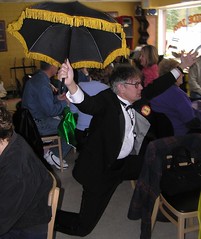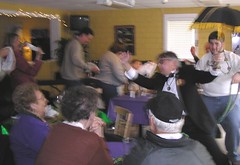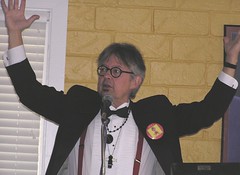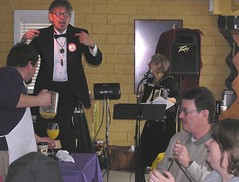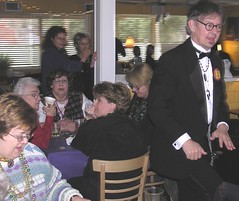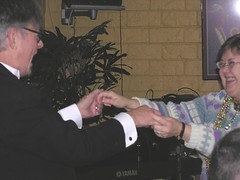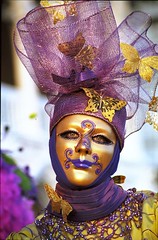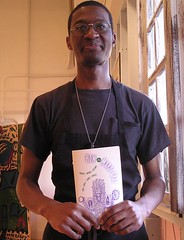Global Carnival and Louisiana:
a quiz on the international implications of Mardi Gras
Robert Trudeau
1. The term Carnival comes from the a) French b) German c) Latin d) English.
2. Carnival means a) "Let us celebrate!" b) "A journey to the New World!" c) "Goodbye to flesh!" d) "Wine and feasting for all!"
3. Rex is the best-known krewe of New Orleans but it is not quite the oldest. That distinction belongs to the Mystick Krewe of a) Zulu b) Proteus c) Comus.
4. The horse-mounted men of the Cajun courir de Mardi Gras ride to their neighbors' farms to entertain and to request a) the loan of their first-born son b) a contribution to the gumbo c) a round of beers d) a kiss from each of the ladies.
5. New Orleans still has nighttime parades illuminated in part by men carrying pole-mounted torches. The torches are called a) doubloons b) dragee c) flambeaux.
6. The New Orleans krewe with the biggest floats and the most throws: a) Zulu b) Comus c) Rex d) Bacchus.
7. New Orleans also celebrates the arrival of Rex at the river front on the day before Fat Tuesday. That day has a French name, too: a) Jeudi Gras b) Lundi Gras c) Dimanche Gras d) Vendredi Gras.
8. The first parade to roll on Mardi Gras morning is the one that traditionally did not print a specific parade route: a) Zulu b) Rex c) Comus.
9. The European nation with the longest Carnival season; it begins in November.
a) Senegal b) Germany c) Brazil d) Trinidad .
10. This European nation features a Women's Parade Day during which the females on the floats may descend into the crowd to grab men for hugs and kisses: a) Brazil b) Jamaica c) Germany d) Italy.
11. Carnival costumes are frequently so large in this Caribbean nation that they must be supported by metal frames and outrigger wheels. The nation: a) Jamaica
b) Trinidad c) Brazil.
12. In England the day we know as Fat Tuesday is called Pancake Day or _____ Tuesday. The word means "to forgive someone's sins." a) Shrove Tuesday b) Mauve Tuesday c) Clove Tuesday.
13. The largest number of people at a Carnival gathering in the world: a) New Orleans b) Munich, Germany c) Rio de Janeiro.
14. T / F New Orleans Mardi Gras was not affected by the graceful dancing and festive costumes seen on African-American slaves as they gathered every Sunday in Congo Square.
15. Nova Scotia was known to the French as a) Canada b) New France c) Acadia
d) Haiti North.
16. Which group of French-speaking colonists came to Louisiana first? a) the Acadians, popularly known as the Cajuns b) French colonists under Governors Iberville and Bienville.
17. The principal region from which slaves were brought to the New World: a) North Africa b) East Africa c) South Africa d) West Africa.
18. The nation that is home to the Roman Catholic Church and place where the first
Carnival masking and parades were seen: a) Italy b) France c) England.
19. T / F The term Creole comes from the Spanish word for "cry." It referred to the cry of a baby born to parents who have emigrated to the New World.
20. Louisiana's Carnival season begins on January 6. That day is also known as a) Twelfth Night b) Tableau Night c) Dionysus Night.
21. Shreveport-Bossier has perhaps half a dozen parading krewes. The New Orleans
area has some a) 25 b) 50 c) 300 parades.
22. The immediate source for traditions and materials in Louisiana's early carnival festivities was a) Paris b) Rome c) Venice d) London.
23. In the city of New Orleans, which was developed first? a) Jazz music b) Mardi Gras.
24. What force connects the culture of South Louisiana to Carnival and makes it difficult for North Louisiana to do the same? a) racial heritage b) poverty
c) socio-religious culture d) history.
25. What unites the various US states who have the biggest propensity to Carnival? a) telecommunications b) the Gulf c) love of costumes d) music.
26. Which group of European colonists used the port of Cadiz as their point of embarkation and debarkation to Louisiana? a) Spain b) France c) Italy d) Portugal.
27. Which group of people spent a year or two on a Caribbean island before being allowed to work in the American colonies? a) Acadians b) Africans c) Creoles.
28. T / F Ethiopia, Nigeria, the Congo: these are the West African nations of America's heritage.
